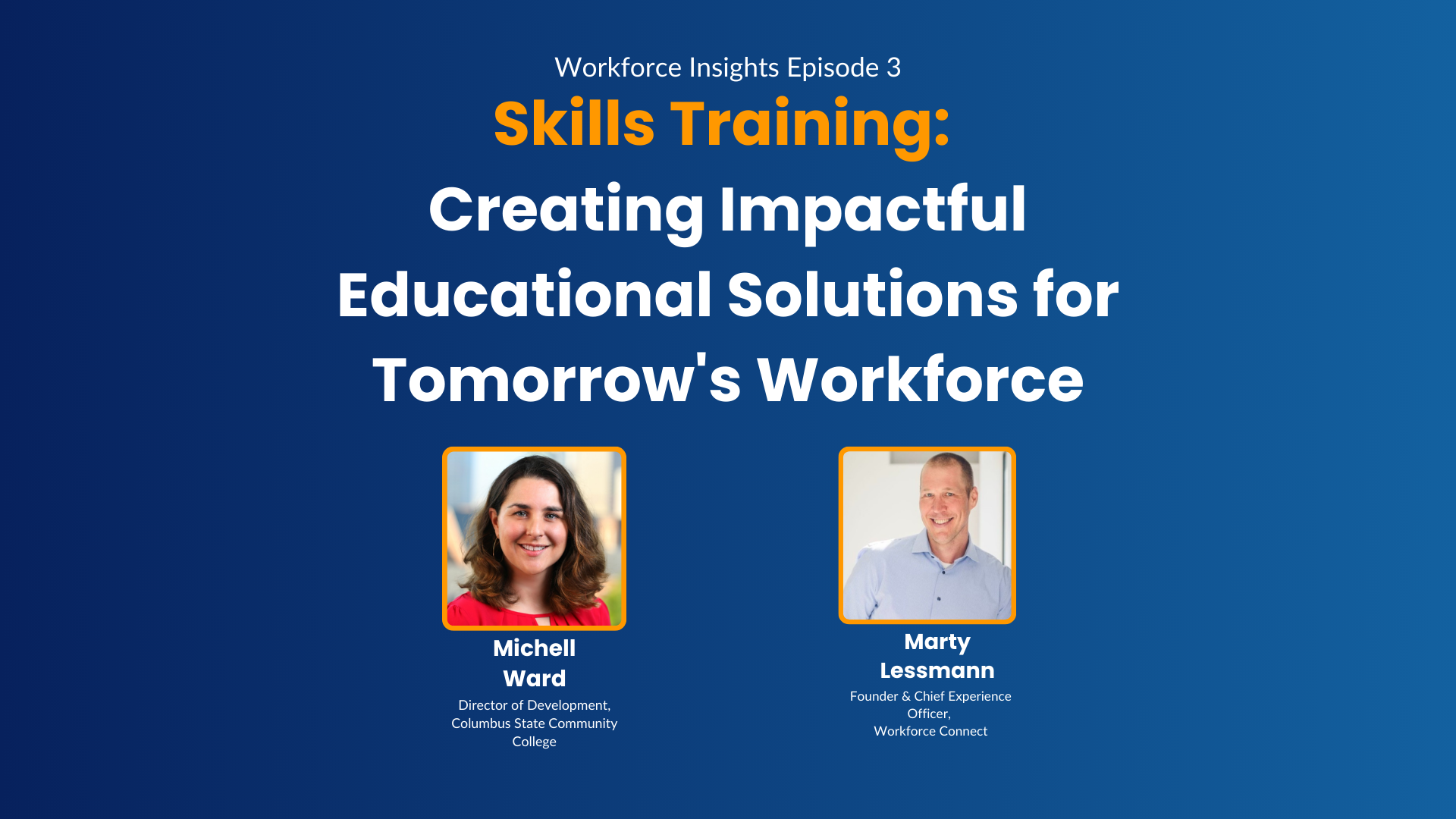Executive Summary
Effective communication is essential to successful workforce partnerships between community and technical colleges, workforce organizations, and employers. However, managing these partnerships can be challenging, especially when employers face multiple points of contact within an organization. This can lead to confusion, inefficiency, and strained relationships. This Workforce Insight explores the common frustrations employers encounter when dealing with multiple contact points, the strategies that community and technical colleges can use to manage their teams more effectively, and the role of thorough documentation in maintaining strong relationships with industry partners. With 76% of employers citing clear communication as a critical factor for successful partnerships (National Skills Coalition, 2023), this Workforce Insight also highlights the best practices for tracking interactions and ensuring that partnerships remain effective and mutually beneficial.
Introduction
Community and technical colleges and workforce organizations play a pivotal role in workforce development, offering tailored training programs that meet the needs of local industries. Successful partnerships with employers are a key component of these efforts, helping to align curricula with market demands and offering students valuable work-based learning opportunities. However, maintaining these partnerships requires more than just good intentions; it demands a structured approach to communication and relationship management.
A report by the American Association of Community Colleges (AACC, 2023) found that over 60% of community colleges struggle with managing communication channels between their institutions and industry partners. Without proper coordination, these interactions can become fragmented, leading to partner fatigue and decreased employer satisfaction.
This Workforce Insight reviews:
- Challenges in managing workforce partnerships
- Strategies for improved communication
- Importance of thorough documentation
- Digital solutions for partnership management
“This tool will enable us to track the outcomes of the work we are trying to accomplish.”

Dr. Stephanie Fujiunity College
President, Arapahoe Community College
Employer Frustrations with Multiple Points of Contact
One of the most common issues employers face when working with educational and workforce organizations is having too many points of contact. This problem can arise when different departments, such as workforce development, career services, academic, and administrative offices, each manage their own relationships with employers. While these departments may have good intentions, the lack of a centralized communication strategy can lead to frustration and confusion for employers.
- Fragmented Communication:58% of employers reported challenges in knowing whom to contact within a college when issues arose (Lumina Foundation, 2022). This fragmentation can delay problem resolution, affect program updates, and hinder the ability to respond to urgent industry needs.
- Inconsistent Messaging: When employers receive mixed messages from different departments, it can create uncertainty about program goals and outcomes, weaken trust, and make it harder for employers to see the value of the partnership. The Community College Research Center (CCRC, 2023) notes that consistency in messaging is a key factor in maintaining strong partnerships.
- Overwhelming Administrative Burden: Employers may not have the time or resources to navigate multiple contacts at a college. This burden can lead to disengagement and a reluctance to participate in future partnership initiatives. According to the U.S. Chamber of Commerce (2023), 45% of small businesses involved in workforce training programs reported dropping out of partnerships due to administrative complexities.
- Difficulty Reaching the Right Person: Employers struggle to identify the appropriate contact within the institution to address their specific needs.
Managing Your Team to Avoid Partner Fatigue
Community and technical colleges and workforce organizations need to manage their internal teams effectively to prevent partner fatigue and ensure that employers have a positive experience. This involves designating clear roles, establishing a single point of contact, and fostering collaboration among departments.
- Centralized Communication Roles: Designating a partnership coordinator or liaison can help streamline communication. This individual acts as the main point of contact for employers, managing all interactions and ensuring that information is disseminated to the appropriate departments within the college. According to AACC (2023), colleges that use a centralized communication model reported a 30% increase in employer satisfaction.
- Cross-Department Collaboration: Encouraging collaboration among departments can help ensure everyone is on the same page when interacting with employers. Regular internal meetings or updates can keep all team members informed about the status of partnerships and upcoming needs or changes. This approach minimizes the risk of duplicate or conflicting communications.
- Clear Internal Protocols: Establishing protocols for internal communication and documentation can help manage the flow of information within a college. For example, requiring that all partnership-related emails be copied to the designated liaison can ensure transparency and prevent misunderstandings.
Managing Your Team to Avoid Partner Fatigue
Community and technical colleges and workforce organizations need to manage their internal teams effectively to prevent partner fatigue and ensure that employers have a positive experience. This involves designating clear roles, establishing a single point of contact, and fostering collaboration among departments.
- Centralized Communication Roles: Designating a partnership coordinator or liaison can help streamline communication. This individual acts as the main point of contact for employers, managing all interactions and ensuring that information is disseminated to the appropriate departments within the college. According to AACC (2023), colleges that use a centralized communication model reported a 30% increase in employer satisfaction.
- Cross-Department Collaboration: Encouraging collaboration among departments can help ensure everyone is on the same page when interacting with employers. Regular internal meetings or updates can keep all team members informed about the status of partnerships and upcoming needs or changes. This approach minimizes the risk of duplicate or conflicting communications.
- Clear Internal Protocols: Establishing protocols for internal communication and documentation can help manage the flow of information within a college. For example, requiring that all partnership-related emails be copied to the designated liaison can ensure transparency and prevent misunderstandings.
Why Documentation is Key to Strong Employer Relationships
Effective documentation is critical for maintaining strong, long-term relationships with employers. It not only helps colleges and workforce organizations track the progress of their partnerships but also ensures continuity, even when staff changes occur. Proper documentation practices can significantly improve the transparency and accountability of workforce development initiatives.
- Tracking Partnership History: Documenting all interactions with employers helps create a clear record of the relationship’s history. This can include notes from meetings, feedback from employers, and records of program updates. Such documentation allows colleges to review what has been discussed and agreed upon, ensuring that all parties remain aligned. The National Skills Coalition (2023) emphasizes that a well-documented partnership history can reduce misunderstandings and build trust.
- Data-Driven Decisions: Maintaining records of employer feedback and program outcomes enables colleges to make data-driven decisions about their partnerships. For example, tracking the number of students hired by a particular employer or the performance of graduates in specific roles can help colleges refine their programs to better meet industry needs. This data can also be used to demonstrate the success of a partnership when applying for additional funding or grants.
- Ensuring Continuity During Transitions: Staff turnover is a common challenge in educational institutions and industry. Proper documentation ensures new staff members can quickly learn about a partnership’s status and history. This continuity is critical for maintaining employer confidence and avoiding disruptions in ongoing programs.
Leveraging Software for Managing and Documenting Workforce Partnerships
A potential solution to the challenges of managing workforce partnerships is implementing a software tool designed specifically for tracking and documenting interactions between community and technical colleges, workforce organizations, and industry partners. This type of platform can centralize all partnership-related communication and standardize workforce partnerships, helping to streamline interactions and ensure that all stakeholders have access to accurate, up-to-date information. By offering features such as contact management, relationship history, task tracking, and real-time updates, the software can prevent the confusion that arises from multiple points of contact. According to a study by the National Skills Coalition (2023), institutions using such digital tools reported a 25% improvement in partnership satisfaction, as they offered more consistent communication and a seamless experience for employers. This digital solution ensures that as staff members transition, the continuity of relationships with employers is maintained, fostering stronger and more effective workforce partnerships.
Conclusion
Tracking workforce partnerships through effective communication and documentation is essential for sustaining successful collaborations between community and technical colleges, workforce organizations, and employers. By managing internal teams to streamline communication, institutions can reduce the frustration employers often feel when navigating multiple points of contact. Additionally, emphasizing thorough documentation practices ensures that partnerships remain consistent and effective, even through staff transitions. As the demand for skilled labor grows, community and technical colleges and workforce organizations must prioritize these practices to maintain strong, mutually beneficial relationships with their industry partners.
References
- American Association of Community Colleges. (2023). The Role of Communication in Workforce Partnerships. AACC Research Brief.
- Community College Research Center. (2023). Managing Employer Relationships in Workforce Development. CCRC Working Paper.
- Lumina Foundation. (2022). Building Effective Partnerships: Challenges and Opportunities. Lumina Foundation Report.
- National Skills Coalition. (2023). Effective Communication Strategies for Workforce Development. National Skills Coalition Annual Report.
- U.S. Chamber of Commerce. (2023). Small Business Engagement in Workforce Training Programs. Chamber of Commerce Report.




